Planetary science laboratory and observeration facilities at UCLA are very diverse and provide researchers with the invaluable ability to perform experimental research and produce empirical data. Ongoing laboratory and observational research programs include (but are not limited to) the study of mineral physics and the response of planetary materials to high pressures; high resolution geochronology with applications to the origin of planetary crust, magma chamber development, cosmochemistry and more; studies of isotopic fractionation of matter incorporated into the nascent protoplanetary nebula; infrared and optical observation of asteroids and comets; studies of meteorites (the UCLA Meteorite Gallery houses one of the largest meteorite collections in the world); and laboratory simulations of rotating planet convection. See below for a comprehensive list and short description of each facility.
Cosmoschemistry and Geochemistry Laboratory (Young Lab)
Director: Edward Young
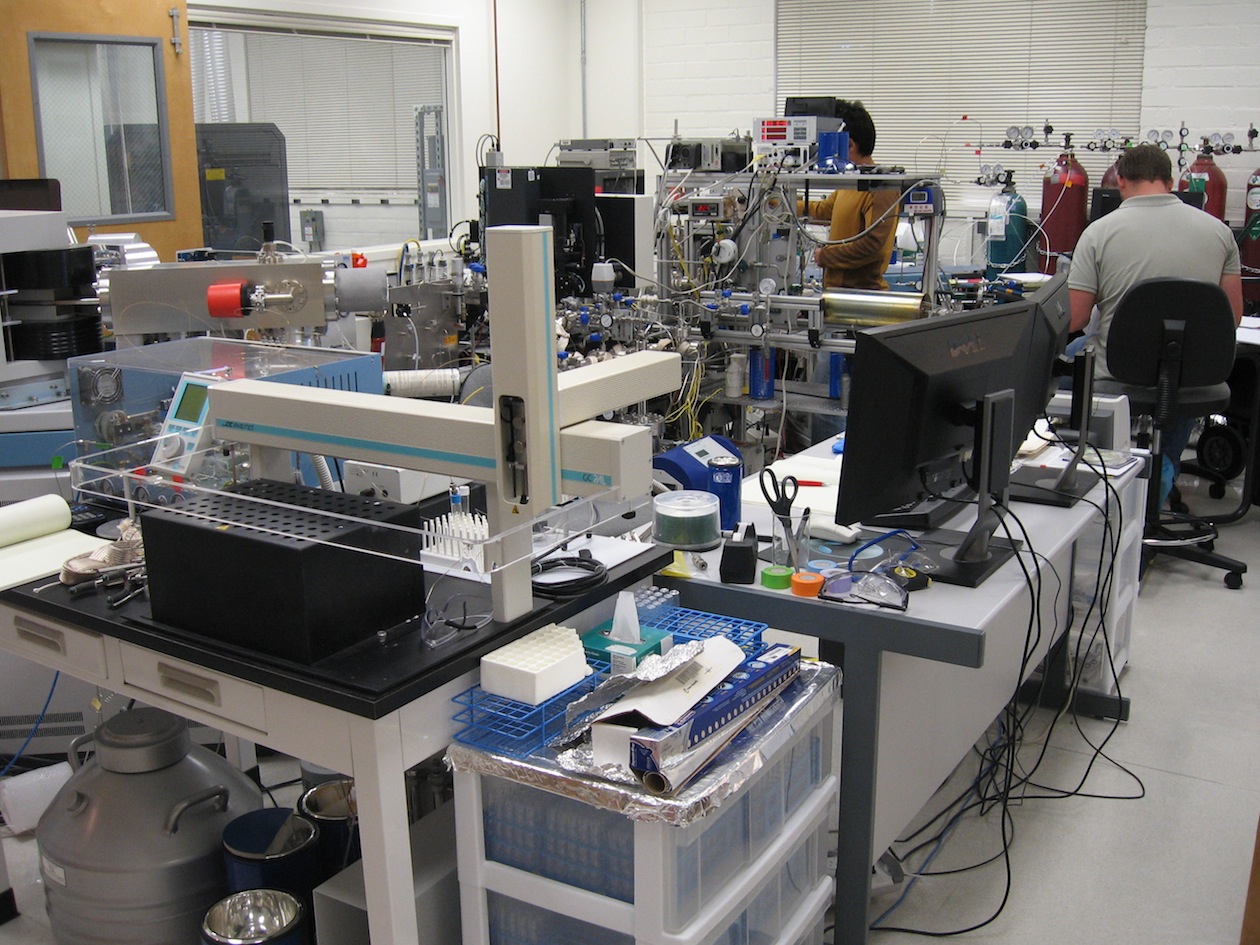
The Young Laboratory is part of the Department of Earth, Planetary, and Space Sciences and is equipped with a high-resolution ThermoFinnigan Neptune multiple-collector inductively coupled plasma mass spectrometer capable of both high precision radiogenic or stable isotope analyses by sampling either by in-situ laser ablation or chemical separation; an ArF Laser Ablation System used for in-situ analysis of isotopes; a Laser Fluorination line attached to a ThermoFinnigan Delta gas-source mass spectrometer used for measuring oxygen isotopic ratios in meteoritical samples; an Ultraviolet Laser Ablation Fluorination System with He carrier flow delivery to a ThermoFinnigan MAT 253 gas-source mass spectrometer; a Cetac Aridus desolvating nebulizer used to reduce hydride and oxide interferences in samples; a ThermoFinnigan Gas Bench system for automated carbonate oxygen and carbon isotope ratio analysis; and a Class 100 rating clean laboratory for cation separation. Current projects being undertaken in the Young Lab include studying isotopes to understand the evolution and photochemistry of protoplanetary disks in the early Solar System, non-traditional stable isotope fractionation at high temperatures and pressures, and astrobiology.
Diviner Cluster
Director: David Paige
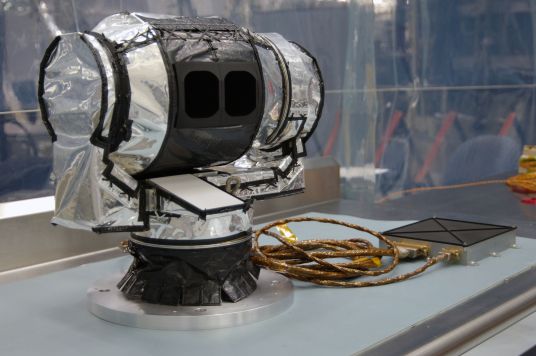
The Diviner cluster is a high-powered super computer located in the Department of Earth, Planetary, and Space Sciences. The cluster contains 1448 CPUs, eight 48 U racks, 4 APC chilled water coolers, a 40 kWatt RMS Powerload and a 1.4 Petabyte disk farm of RAID 6 storage. Currently, the cluster is utilized for modeling thermal signatures on the varied topography of the Moon and Mercury.
Experimental Petrology Lab (PTX Lab)
Director: Craig Manning

The PTX Lab, located in the Department of Earth, Planetary, and Space Sciences contains low-, moderate-, and high-pressure piston cylinder presses permitting pressures up to 30 kilobars, an Enerpac utility press, cold-seal hydrothermal bombs, and high-temperature one-atmosphere box furnaces. Ongoing research in the PTX Lab includes chemistry of dense fluids in environments such as lower crust, subduction zones, and the oceans of icy moons of Jupiter and Saturn, the effect of fluid-rock interaction on atmospheric evolution, the solubility of hydrogen in nominally anhydrous minerals, and the partitioning of stable isotopes of Fe and Mg among minerals and melts at high temperature.
Geology and Geophysics Library
Location: Geology 4697
Phone: 310.825.1055
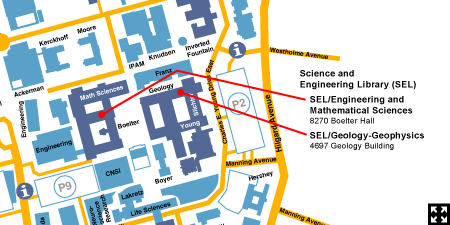
The UCLA Library is one of the top-ranked research libraries in the United States. It is greatly enhanced by the California Digital Library (CDL), which supports on-line the shared collections of the University of California and others, including the Melvyl Union Catalog, the California Periodicals database, CDL-hosted databases, archival collections held by UC and other California universities and museums, electronic journals, and other scholarly resources. The Geology & Geophysics Collection located in the Geology Building is part of the Science & Engineering Library (SEL), which also includes Chemistry, Physics, and Engineering/Mathematical Sciences collections. The Geology/Geophysics Collection is one of the largest repositories of geoscience literature in the country. It is strong in geology, geochemistry, geophysics, space physics, planetary science, and regional geology. Field-trip guidebooks, open-file reports, and CD-ROM databases are collected in addition to books and journals.The adjoining William C. Putnam Map Collection holds 90,000 topographic and geologic maps, and is a depository library for USGS geologic map series and topographic maps for California, Nevada, and Arizona.
Infrared Laboratory (IR Lab)
Director: Ian McLean
Deputy Director: James Larkin
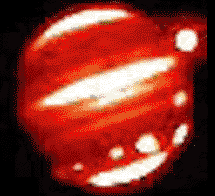
Housed in the UCLA Physics and Astronomy department, the goal of the IR Lab is to advance the techniques and applications of infrared imaging devices, develop infrared cameras and spectrometers, and support observational programs to study brown dwarfs and planets, star formation, and galaxies. To date, the IR lab has developed instruments such as K-Cam, Gemini, USNO Infrared Camera, NIRSPEC, NIRC2, OSIRIS, SHARC, FLITECAM, and MOSFIRE for use on telescopes, including the 10-meter W.M. Keck Telescope, 3-meter Shane Telescope at Lick Observatory, airborne NASA SOFIA Observatory. Currently, the IR Lab, with PI James Larkin, is developing the Gemini Planet Imager (GPI) for the Gemini South Telescope and an Infrared Imaging Spectrograph (IRIS) for the Thirty Meter Telescope in Hawaii. In addition, the IR Lab currently supports the Brown Dwarf Spectroscopic Survey and Center for Adaptive Optics Treasury Survey observational programs. Mike Fitzgerald is also developing a more powerful imager for the OSIRIS instrument at the W.M. Keck Observatory.
Meteorite Collection/Gallery
Directors: John Wasson and Alan Rubin
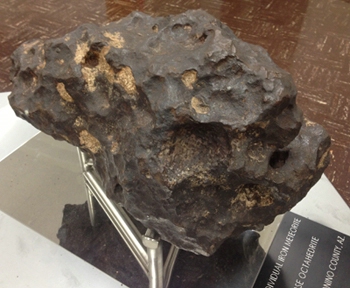
The UCLA Meteorite Collection and Gallery is housed within the Department of Earth, Planetary and Space Sciences at UCLA. The collection is one of the most extensive in the world, containing more than 1500 meteorite samples, many products of impacts (tektites, impact glasses, etc.), and plenty of meteorite-wrongs. Meteorite samples are constantly being added to the collection and are actively studied in various laboratories at UCLA and other institutes.
Mineral Physics Laboratory
Director: Abby Kavner
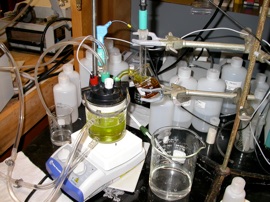
The Mineral Physics Laboratory is located within the Department of Earth, Planetary and Space Sciences at UCLA, and is equipped with a diamond cell apparatus that has capabilities for ruby fluorescence, Raman spectroscopy, and double-sided laser heating and imaging spectroradiometry. Current research includes understanding the mineral properties of Earth and planetary interiors, geochemical signatures of electrochemical processes, materials physics and chemistry under extreme conditions and the behavior of carbon at high pressures and temperatures.
Secondary Ion/Accelerator Mass Spectrometer (MegaSIMS) Laboratory
Director: Kevin McKeegan
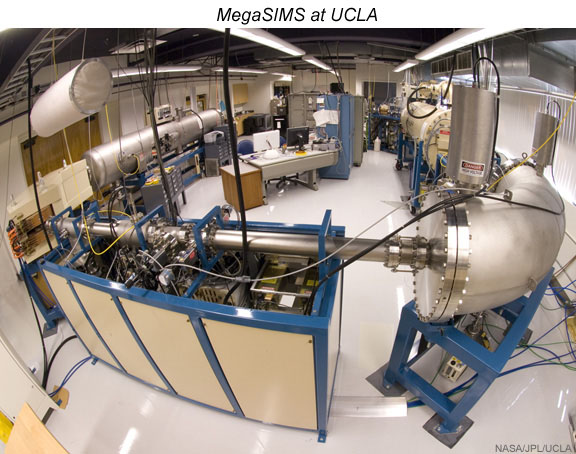 The MegaSIMS Lab is located within the Department of Earth, Planetary and Space Sciences at UCLA. Originally and specifically developed to analyze cosmochemical samples returned from NASA’s GENESIS mission, the MegaSIMS is capable of studying dilute and limited samples that came in proximity to contamination (by solar wind ions). The MegaSIMS is composed of a Secondary Ion Mass Spectrometer (SIMS) coupled to an accelerator mass spectrometer (AMS) through a band-pass mass filter (the recombinator). Although the GENESIS mission concluded in 2004, the MegaSIMS is still actively utilized to analyze common elements, such as oxygen and nitrogen, which were collected from the Sun during the mission, in hopes of providing new insights concerning the composition of the early solar system and solar nebula.
The MegaSIMS Lab is located within the Department of Earth, Planetary and Space Sciences at UCLA. Originally and specifically developed to analyze cosmochemical samples returned from NASA’s GENESIS mission, the MegaSIMS is capable of studying dilute and limited samples that came in proximity to contamination (by solar wind ions). The MegaSIMS is composed of a Secondary Ion Mass Spectrometer (SIMS) coupled to an accelerator mass spectrometer (AMS) through a band-pass mass filter (the recombinator). Although the GENESIS mission concluded in 2004, the MegaSIMS is still actively utilized to analyze common elements, such as oxygen and nitrogen, which were collected from the Sun during the mission, in hopes of providing new insights concerning the composition of the early solar system and solar nebula.
Simulated Platenary Interiors Laboratory (SPINLab)
Director: Jonathan Aurnou
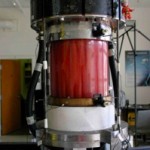
The SPINLab is 900 square foot experimental fluid dynamics facility located in the Department of Earth, Planetary, and Space Sciences (Geology Building). SPINLab facilities and equipment include a custom heavy-duty rotary table, a Walker LDJ 35 cm bore solenoidal exlectromagnet, a MetFlow UVP-Duo MX ultrasonic Doppler velocimetry system, temperature and magnetic field sensors coupled to a National Instruments data acquisition system, industrial and precision closed-loop temperature baths, blackout shades capable of providing 99% darkness for sensitive flow visualization experiments, and dedicated 400 amps of 3 phase electrical power capability. Some of the projects being undertaken in the lab include the study of interior dynamics of giant planets, librationally-driven planetary fluid dynamics, effects of topographic boundary heterogeneity on Earth’s core dynamics, and the rotating magnetoconvection project (RoMag).
Laboratory for Analog Modeling of Planetary Surfaces (LAMPS)
Director: An Yin
Manager: Ivy Curren

The Laboratory for Analog Modeling of Planetary Surfaces is housed in the Department of Earth, Planetary, and Space Sciences. The primary experimental apparatus is comprised of three step-motor driven aluminum plates that are capable of simulating lithospheric deformation under complex interactions of velocity and thermal boundary conditions. Velocity boundary conditions including lateral push and pull, basal shearing and regional tilt can vary with time. Meanwhile, the thermal boundary conditions implemented at the base of the apparatus via thermal couples can vary with time and space. Current research includes investigating kinematic evolution and mechanics of tectonic development on planetary bodies such as Earth, Mars, Venus, Enceladus and Europa.
W.M. Keck Foundation Center for Isotope Geochemistry Secondary Ion Mass Spectrometer Laboratory (SIMS Lab)
Directors: Kevin McKeegan and Mark Harrison
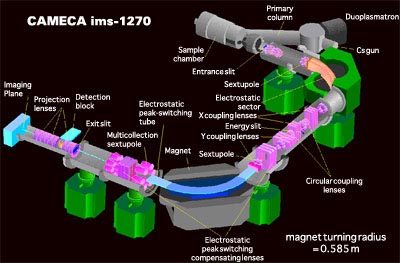
The SIMS Lab is housed in the Department of Earth, Planetary and Space Sciences at UCLA. The lab is comprised several instruments: the CAMECA IMS 1270, the nation’s first high-resolution/high-sensitivity ion microprobe; two VG sector thermal ionization mass spectrometers equipped with both laser and resistance heating gas axtraction for thermochronological investigations using Ar-Ar and U-He methods; a JEOL SuperProbe electron microprobe analyzer with five spectrometers; and a variable pressure LEO 1430 VP Scanning Electron Microscope equipped with a 4-quadrant backscattered electron detector, an energy-dispersive x-ray analyzer and cathodoluminescence detector. Current research in the SIMS lab using geochronology, stable isotope, ion imaging/depth profiling, and trace element applications includes high spatial resolution geochronology, crustal evolution, magma chamber processes, studying the ancient Earth, cosmochemistry, biological links to geochemistry and astrobiology, environmental tracers, paleoclimatology, and combined Uranium-Thorium-Helium dating techniques.
PANORAMA Lab
Director: Edward Young
The PANORAMA Lab is a brand new (as of March 2015) edition to the UCLA Department of Earth, Planetary, and Space Sciences. The lab is equipped with a one of a kind high-definition gas-sources mass spectrometer.
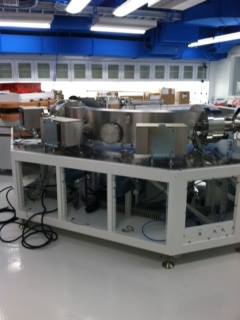
Miscellaneous
The Department of Earth, Planetary and Space Sciences has many other resources which are not part of large laboratories. These include:
- a portable array of broadband seismometers;
- an campus seismic network that is part of the the Center for Embedded Networked Sensing, an inter-disciplinary NSF Science and Technology Center developing sensor networks technology;
- off-road vehicles;
- thin-section and rock-crushing labs
- electronics and prototyping shops;
- a GIS database and map server;
- a computerized Visualization Portal.
Related Videos
http://www.youtube.com/watch?v=PFzpei8Qgxw
